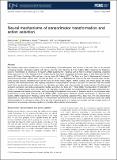| dc.contributor.author | Huda, Rafiq | |
| dc.contributor.author | Goard, Michael J | |
| dc.contributor.author | Pho, Gerald N | |
| dc.contributor.author | Sur, Mriganka | |
| dc.date.accessioned | 2021-10-27T19:52:37Z | |
| dc.date.available | 2021-10-27T19:52:37Z | |
| dc.date.issued | 2019 | |
| dc.identifier.uri | https://hdl.handle.net/1721.1/133397 | |
| dc.description.abstract | © 2018 Federation of European Neuroscience Societies and John Wiley & Sons Ltd Ray Guillery made major contributions to our understanding of the development and function of the brain. One of his principal conceptual insights, developed together with Murray Sherman [S.M. Sherman & R.W. Guillery (2001) Exploring the Thalamus. Elsevier, Amstrerdam; S. Sherman & R. Guillery (2006) Exploring the Thalamus and Its Role in Cortical Functioning. Academic Press, New York, NY; S.M. Sherman & R.W. Guillery (2013) Functional Connections of Cortical Areas: A New View from the Thalamus. MIT Press, Cambridge, MA and then in his last book (R. Guillery (2017) The Brain as a Tool: A Neuroscientist's Account. Oxford University Press, Oxford, UK)], was that the brain is a ‘tool’ to understand the world. In this view, the brain does not passively process sensory information and use the result to inform motor outputs. Rather, sensory and motor signals are widely broadcast and inextricably linked, with ongoing sensorimotor transformations serving as the basis for interaction with the outside world. Here, we describe recent studies from our laboratory and others which demonstrate this astute framing of the link among sensation, perception, and action postulated by Guillery and others [G. Deco & E.T. Rolls (2005) Prog Neurobiol, 76, 236–256; P. Cisek & J.F. Kalaska (2010) Annu Rev Neurosci, 33, 269-298]. Guillery situated his understanding in the deeply intertwined relationship between the thalamus and cortex, and importantly in the feedback from cortex to thalamus which in turn influences feed-forward drive to cortex [S.M. Sherman & R.W. Guillery (2001) Exploring the Thalamus. Elsevier, Amstrerdam; S. Sherman & R. Guillery (2006) Exploring the Thalamus and Its Role in Cortical Functioning. Academic Press, New York, NY]. We extend these observations to argue that brain mechanisms for sensorimotor transformations involve cortical and subcortical circuits that create internal models as a substrate for action, that a key role of sensory inputs is to update such models, and that a major function of sensorimotor processing underlying cognition is to enable action selection and execution. | |
| dc.language.iso | en | |
| dc.publisher | Wiley | |
| dc.relation.isversionof | 10.1111/EJN.14069 | |
| dc.rights | Creative Commons Attribution-Noncommercial-Share Alike | |
| dc.rights.uri | http://creativecommons.org/licenses/by-nc-sa/4.0/ | |
| dc.source | MIT web domain | |
| dc.title | Neural mechanisms of sensorimotor transformation and action selection | |
| dc.type | Article | |
| dc.contributor.department | Picower Institute for Learning and Memory | |
| dc.contributor.department | Massachusetts Institute of Technology. Department of Brain and Cognitive Sciences | |
| dc.relation.journal | European Journal of Neuroscience | |
| dc.eprint.version | Author's final manuscript | |
| dc.type.uri | http://purl.org/eprint/type/JournalArticle | |
| eprint.status | http://purl.org/eprint/status/PeerReviewed | |
| dc.date.updated | 2019-10-04T13:24:01Z | |
| dspace.orderedauthors | Huda, R; Goard, MJ; Pho, GN; Sur, M | |
| dspace.date.submission | 2019-10-04T13:24:01Z | |
| mit.journal.volume | 49 | |
| mit.journal.issue | 8 | |
| mit.metadata.status | Authority Work and Publication Information Needed | |
